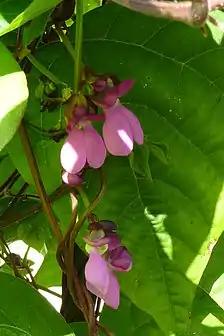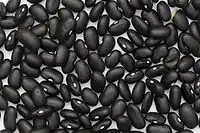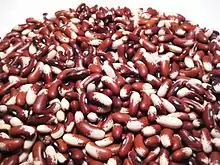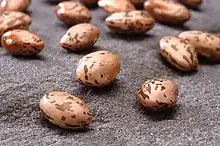Phaseolus vulgaris
Phaseolus vulgaris, also known as the common bean[2] and French bean,[3] is a herbaceous annual plant grown worldwide for its edible dry seeds or unripe fruit (both commonly called beans). The main categories of common beans, on the basis of use, are:
- dry beans (seeds harvested at complete maturity),
- snap beans (tender pods with reduced fibre harvested before the seed development phase), and
- shell (shelled) beans (seeds harvested at physiological maturity).
| Phaseolus vulgaris | |
|---|---|
 | |
A flat-podded variety of the common bean | |
| Scientific classification | |
| Kingdom: | Plantae |
| Clade: | Tracheophytes |
| Clade: | Angiosperms |
| Clade: | Eudicots |
| Clade: | Rosids |
| Order: | Fabales |
| Family: | Fabaceae |
| Genus: | Phaseolus |
| Species: | P. vulgaris |
| Binomial name | |
| Phaseolus vulgaris | |
| Synonyms[1] | |
| |



Its leaf is also occasionally used as a vegetable and the straw as fodder. Its botanical classification, along with other Phaseolus species, is as a member of the legume family Fabaceae. Like most members of this family, common beans acquire the nitrogen they require through an association with rhizobia, which are nitrogen-fixing bacteria.
Species variability
The common bean is a highly variable species that has a long history of cultivation. All wild members of the species have a climbing habit,[4][5] but many cultivars are classified either as bush beans or dwarf beans, or as pole beans or climbing beans, depending on their style of growth.
Phaseolus vulgaris varieties include the kidney bean, the navy bean, the pinto bean, and the wax bean.[6]
The other major types of commercially grown bean are the runner bean (Phaseolus coccineus) and the broad bean (Vicia faba).
Beans are grown on every continent except Antarctica. Worldwide, 27 million tonnes of dried beans and 24 million tonnes of green beans were grown in 2016.[7] In 2016, Myanmar was the largest producer of dried beans, while China produced 79% of the world total of green beans.
The wild P. vulgaris is native to the Americas. It was originally believed that it had been domesticated separately in Mesoamerica and in the southern Andes region, giving the domesticated bean two gene pools.[8]
However, recent genetic analyses show that it was actually domesticated in Mesoamerica first, and traveled south, probably along with squash and maize (corn). The three Mesoamerican crops constitute the "Three Sisters" central to indigenous North American agriculture.[9]
Description
The common bean is a highly variable species with a long history. Bush varieties form erect bushes 20–60 cm (8–20 in) tall, while pole or running varieties form vines 2–3 m (7–10 ft) long.
Leaves - All varieties bear alternate, green or purple leaves, which are divided into three oval, smooth-edged leaflets, each 6–15 cm (2–6 in) long and 3–11 cm (1–4 in) wide.
Flowers - The white, pink, or purple flowers are about 1 cm long, and they give way to pods 8–20 cm (3–8 in) long and 1–1.5 cm wide. These may be green, yellow, black, or purple in color, each containing 4–6 beans.
Beans - The beans are smooth, plump, kidney-shaped, up to 1.5 cm long, range widely in color, and are often mottled in two or more colors. Raw or undercooked beans contain a toxic protein called phytohaemagglutinin.[10]:254
Dry beans
Similar to other beans, the common bean is high in starch, protein, and dietary fiber, and is an excellent source of iron, potassium, selenium, thiamine, vitamin B6, and folate.
Dry beans will keep indefinitely if stored in a cool, dry place, but as time passes, their nutritive value and flavor degrade and cooking times lengthen.
Dried beans are almost always cooked by boiling, often after being soaked in water for several hours. While the soaking is not strictly necessary, it shortens cooking time and results in more evenly textured beans. In addition, soaking beans removes 5 to 10% of the gas-producing sugars that can cause flatulence for some people.[11]
The methods include simple overnight soaking and the power soak method in which beans are boiled for three minutes and then set aside for 2–4 hours. Before cooking, the soaking water is drained off and discarded. Dry common beans take longer to cook than most pulses: cooking times vary from one to four hours, but are substantially reduced with pressure cooking.
In Mexico, Central America, and South America, the traditional spice used with beans is epazote, which is also said to aid digestion. In East Asia, a type of seaweed, kombu, is added to beans as they cook for the same purpose.
Salt, sugar, and acidic foods such as tomatoes may harden uncooked beans, resulting in seasoned beans at the expense of slightly longer cooking times.
Dry beans may also be bought cooked and canned as refried beans, or whole with water, salt, and sometimes sugar.
Green beans and wax beans
The three commonly known types of green beans are:
- string or snap beans, which may be round or have a flat pod;
- stringless or French beans, which lack a tough, fibrous string running along the length of the pod; and
- runner beans, which belong to a separate species, Phaseolus coccineus.
Green beans may have a purple rather than green pod, which changes to green when cooked.[12]
Wax beans are P. vulgaris beans that have a yellow[4] or white pod. Wax bean cultivars are commonly grown;[4] the plants are often of the bush or dwarf form.[4]
As the name implies, snap beans break easily when the pod is bent, giving off a distinct audible snap sound. The pods of snap beans (green, yellow and purple in colour) are harvested when they are rapidly growing, fleshy, tender (not tough and stringy), bright in colour, and the seeds are small and underdeveloped (8 to 10 days after flowering).
Compared to dry beans, green and wax beans provide less starch and protein and more vitamin A and vitamin C. Green beans and wax beans are often steamed, boiled, stir-fried, or baked in casseroles.
Shelling beans
Shell, shelled, or shelling beans are beans removed from their pods before being cooked or dried. Common beans can be used as shell beans, but the term also refers to other species of beans whose pods are not typically eaten, such as lima beans, soybeans, peas, and fava beans.
Fresh shell beans are nutritionally similar to dry beans, but are prepared more like a vegetable, often being steamed, fried, or made into soups.
Popping beans
The nuña is an Andean subspecies, P. v. subsp. nunas (formerly P. vulgaris Nuñas group), with round, multicolored seeds that resemble pigeon eggs. When cooked on high heat, the bean explodes, exposing the inner part, in the manner of popcorn and other puffed grains.
Cultivars and varieties
Some scientists have proposed Mesoamerica as a possible origin for the common bean. Scientists disagree over whether the common bean was a product of one or multiple domestication events. Over time two diverse gene pools emerged: the Andean gene pool from Southern Peru to Northwest Argentina and the Mesoamerican gene pool between Mexico and Colombia.[13]
Large-seeded varieties of the domesticated bean have been found in the highlands of Peru, dating to 2300 BC, and spreading to the coastal regions by around 500 BC.[14] Small-seeded varieties were found in sites in Mexico, dating to 300 BC, which then spread north and east of the Mississippi River by 1000 AD.[14]
Many well-known bean cultivars and varieties belong to this species, and the list below is in no way exhaustive. Both bush and running (pole) cultivars/varieties exist. The colors and shapes of pods and seeds vary over a wide range.
| Name | Image | Description |
|---|---|---|
| Anasazi | .jpg.webp) |
Anasazi beans are a dappled red and white bean first cultivated by Ancestral Puebloan people around 130 CE in what is now the Four Corners region of the United States. They were adopted by commercial growers beginning in the 1980s and marketed under the name "Anasazi"; traditionally they were known by the Spanish names frijol conejo (rabbit bean), vaquita (little cow), or pajaro carpintero (woodpecker).[15][16] |
| Appaloosa | Front portion of the bean is ivory colored; the other end is speckled with purple and mocha. The bean is named after the Appaloosa ponies of the Nez Perce tribe. The seed was cultivated near the Palouse River in Eastern Washington and Northern Idaho. | |
| Black turtle |  |
The black turtle bean has small, shiny black seeds. It is especially popular in Latin American cuisine. |
| Calypso |  |
Calypso beans are half black, half white, with one or two black dots in the white area. When young, the pods can be harvested as a green bean. But when full-grown, they are used as a bean for drying. |
| Cranberry | Cranberry beans originated in Colombia as the cargamanto bean. Borlotti or Roman beans are a variety of cranberry bean bred in Italy to have a thicker skin. They are much used in Mediterranean cuisine. | |
| Dragon tongue |  |
Dragon tongue bean is young green bean of cranberry bean, pinto bean. It is a flavorful, juicy bean whose seeds are encased in a buffed colorful pod with mottled burgundy patterns throughout the shell's surface. The shelled beans are pale pistachio green in color, their size, petite, and their shape, ovate and slightly curved.[17] |
| Flageolet |  |
Flageolet beans are picked before full maturity and dried in the shade to retain a green color and a distinct taste. The seeds are small, light green, and kidney-shaped. The texture is firm yet creamy if shelled and cooked when fresh but semi-dry. They are often eaten in France, where they traditionally accompany lamb. |
| Kidney |  |
Kidney beans, also known as red beans, are named for their visual resemblance in shape and color to kidneys. They are sometimes used in chili con carne, and are an integral part of the cuisine in northern regions of India. They are also used in New Orleans and much of southern Louisiana for the Monday Creole dish of red beans and rice as well as the Caribbean habichuelas guisadas and Central American gallo pinto. |
| Pea |  |
A type of P. vulgaris called pea bean has been recorded in Britain since the 16th century.[18] In the US, the name "pea bean" is also used to describe small white beans, and the same name is used for Vigna unguiculata subsp. sesquipedalis, also called yard-long bean and cowpea.[19] The seeds of the British pea bean are bicolored red-brown and white. The plants are a typical climbing bean. The beans are either eaten in the pod like French beans or they may be harvested when mature and eaten as other dried beans.[20] |
| Pink | Pink beans are small, pale pink, oval-shaped beans also known by the Spanish name habichuelas rosadas.[21] The Santa Maria pinquito (Spanglish = pink and small), is commercially grown on the mesas above Santa Maria, California, and is a necessary ingredient in Santa Maria-style barbecue. | |
| Pinto |  |
Pinto beans are named for their mottled skin (Spanish: pinto = painted or mottled). They are the most common bean in the United States[22] and northwestern Mexico,[23] and are most often eaten whole in broth or mashed and refried. Either whole or mashed, they are a common filling for burritos. The young pods may also be harvested and cooked as green pinto beans. |
| Rattlesnake | A medium-sized, oblong bean with light brown seeds striped with brown markings. Named for the snake-like manner in which their pods coil around the vine.[24] | |
| White |  |
Navy beans or haricot beans are particularly popular in the United Kingdom and the United States. Other white beans include cannellini, a popular variety in central and southern Italy that is related to the kidney bean. White beans are the most abundant plant-based source of phosphatidylserine known.[25] |
| Yellow | 'Sinaloa Azufrado', 'Sulphur', 'Mayocoba', and 'Peruano' (also called canary) are types of yellow beans. Peruano beans are small, oval, yellow beans about 1/2 in (1 cm) long with a thin skin. They have a creamy texture when cooked. Despite the name ('Peruvian beans' in Spanish), they are native to Mexico. Yellow beans are uncommon in the United States due to a controversial patent issued in 1999 to John Proctor, who selected and named a strain of yellow bean from seeds he brought back from Mexico. U.S. Patent No. 5,894,079 (the Enola or yellow bean patent) granted POD-NERS, LLC., exclusive right to import and sell yellow beans in the United States from 1999 through 2008, when the patent was rejected after reexamination.[26][27] | |
| Tongue of Fire | Tongue of Fire (also known as Horto)[28] has ivory white pods with red streaks that look like flames. The bean stalks grow close together, require plenty of sun and form large roundish pods. Original seed was reportedly from Tierra del Fuego on the tip of South America, sent to Italy and spread through southern Europe. |
Production
In 2016, world production of green beans was 23.6 million tonnes, led by China with 79% of the total (table). World dried bean production in 2016 was 26.8 million tonnes, with Myanmar, India, and Brazil as leading producers (table).
|
|
| ||||||||||||||||||||||||||||||||||||||
Toxicity
The toxic compound phytohaemagglutinin, a lectin, is present in many common bean varieties, but is especially concentrated in red kidney beans. White kidney beans contain about a third as much toxin as the red variety; broad beans (Vicia faba) contain 5 to 10% as much as red kidney beans.[10]
Phytohaemagglutinin can be deactivated by cooking beans for ten minutes at boiling point (100 °C, 212 °F). Insufficient cooking, such as in a slow cooker at 80 °C/ 176 °F, however, is not sufficient to deactivate all toxin.[29] To safely cook the beans, the U.S Food and Drug Administration recommends boiling for 30 minutes to ensure they reach a sufficient temperature for long enough to completely destroy the toxin.[30] For dry beans, the FDA also recommends an initial soak of at least 5 hours in water which should then be discarded.[10] Outbreaks of poisoning have been associated with cooking kidney beans in slow cookers.[10]
The primary symptoms of phytohaemagglutinin poisoning are nausea, vomiting, and diarrhea. Onset is from one to three hours after consumption of improperly prepared beans, and symptoms typically resolve within a few hours.[10] Consumption of as few as four or five raw, soaked kidney beans can cause symptoms.[10] Canned red kidney beans, though, are safe to use immediately, as they have already been cooked.[31][32][33]
Beans are high in purines, which are metabolized to uric acid. Uric acid is not a toxin as such, but may promote the development or exacerbation of gout. However, more recent research has questioned this association, finding that moderate intake of purine-rich foods is not associated with increased risk of gout.[34]
Other uses
Bean leaves have been used to trap bedbugs in houses.[35] Microscopic hairs (trichomes) on the bean leaves entrap the insects.[35]
From ancient times, beans were used as device in various methods of divination. Fortune-telling using beans is called favomancy.
See also
Footnotes
References
- "The Plant List: A Working List of All Plant Species".
- Gentry, Howard Scott (1969). "Origin of the Common Bean, Phaseolus vulgaris". Economic Botany. New York: New York Botanical Garden Press. 23 (1): 55–69. doi:10.1007/BF02862972. JSTOR 4253014. S2CID 29555157.
- "French Beans". Royal Horticultural Society. Retrieved 2020-06-23.
- Phillips, R.; Rix, M. (1993). Vegetables. New York: Random House. ISBN 9780679750246.
- Raja, Vicente; Silva, Paula L.; Holghoomi, Roghaieh; Calvo, Paco (2020-11-10). "The dynamics of plant nutation". Scientific Reports. 10 (1): 19465. doi:10.1038/s41598-020-76588-z. ISSN 2045-2322.
- "Phaseolus vulgaris". Germplasm Resources Information Network (GRIN). Agricultural Research Service (ARS), United States Department of Agriculture (USDA). Retrieved September 22, 2013.
- "Green bean production in 2016, Crops/Regions/World list/Production Quantity (pick lists)". UN Food and Agriculture Organization, Corporate Statistical Database (FAOSTAT). 2017. Retrieved 27 September 2018.
- Paul Gepts (December 1998). "Origin and evolution of common bean: past events and recent trends". HortScience. 33 (7): 1124–1130. doi:10.21273/HORTSCI.33.7.1124.
- Hill, Christina Gish (2020-11-20). "Returning the 'three sisters' – corn, beans and squash – to Native American farms nourishes people, land and cultures". The Conversation. Retrieved 2021-01-08.
- "Bad Bug Book: Handbook of Foodborne Pathogenic Microorganisms and Natural Toxins: Phytohaemagglutinin" (PDF). United States Food and Drug Administration. Archived (PDF) from the original on 2013-04-18. Retrieved 2020-04-17.
- Rombauer, Irma S. The Joy of Cooking. Scribner, ISBN 0-684-81870-1, p. 271.
- Press, L. (2002). The Bean Book: Over Seventy Incredible Recipes. Globe Pequot Press. ISBN 9781585744732.
- Nadeem, Muhammad Azhar; Habyarimana, Ephrem; Çiftçi, Vahdettin; Nawaz, Muhammad Amjad; Karaköy, Tolga; Comertpay, Gonul; Shahid, Muhammad Qasim; Hatipoğlu, Rüştü; Yeken, Mehmet Zahit; Ali, Fawad; Ercişli, Sezai; Chung, Gyuhwa; Baloch, Faheem Shehzad (2018-10-11). "Characterization of genetic diversity in Turkish common bean gene pool using phenotypic and whole-genome DArTseq-generated silicoDArT marker information". PLOS ONE. 13 (10): –0205363. Bibcode:2018PLoSO..1305363N. doi:10.1371/journal.pone.0205363. ISSN 1932-6203. PMC 6181364. PMID 30308006.
- Pearman, Georgina (2005). Prance, Ghillean; Nesbitt, Mark (eds.). The Cultural History of Plants. Routledge. pp. 143–144. ISBN 0415927463.
- Wittenberg, Margaret M. (2013). The Essential Good Food Guide (3 ed.). Berkeley: Ten Speed Press. p. 145. ISBN 9781607744344. Retrieved June 10, 2019.
- Wood, Rebecca (May 2, 1993). "Oh, Beans! The Anasazi is 7,000 years old and still growing". Albuquerque Journal. Retrieved June 11, 2019 – via Newspapers.com.
- "Dragon Tongue Shelling Beans". Specialty Produce. Retrieved 15 September 2016.
- "The Herball or Generall Historie of Plantes (1597)". mpg.de. p. 1040.
The party coloured kidney bean of Egypt Phaseolus aegypticus
- "Vigna unguiculata subsp. sesquipedalis". Germplasm Resources Information Network (GRIN). Agricultural Research Service (ARS), United States Department of Agriculture (USDA). Retrieved September 22, 2013.
- – The National Vegetable Society – the Pea bean Archived January 25, 2007, at the Wayback Machine
- "Pink Bean – Definition and Cooking Information". RecipeTips.com. Retrieved 2012-01-14.
- "Maize 2003 CGC Meeting". Ars-grin.gov. Archived from the original on 2012-09-15. Retrieved 2012-01-14.
- Archived April 10, 2005, at the Wayback Machine
- Ron Herbst; Sharon Tyler Herbst (2015). The Deluxe Food Lover's Companion, 2nd edition. Barron's Educational Series. pp. 1439–. ISBN 978-1-4380-7621-8.
- Souci SW, Fachmann E, Kraut H (2008). Food Composition and Nutrition Tables. Medpharm Scientific Publishers Stuttgart.
- "The Enola Bean Patent Controversy: Biopiracy, Novelty And Fish-And-Chips". Law.duke.edu. Retrieved 2012-01-14.
- "Appeal 2007-3938" (PDF). Retrieved 2012-01-14.
- "A sampling of bean cultivars". The University of Melbourne. Retrieved 2008-01-30.
- Bad Bug Book SE (2017). "Foodborne Pathogenic Microorganisms and Natural Toxins Handbook Phytohaemagglutinin". US Food and Drug Administration. Retrieved 23 August 2017.
- "Bad Bug Book (2012)" (PDF). Foodborne Pathogenic Microorganisms and Natural Toxins Handbook: Phytohaemagglutinin. Food and Drug Administration. 2012. Retrieved 26 December 2013.
Consumers should boil the beans for at least 30 minutes to ensure that the product reaches sufficient temperature
- "Be Careful With Red Kidney Beans in The Slow Cooker". Mother Earth News.
- "Cooking safely with slow cookers and crock pots". foodsmart.govt.nz. Archived from the original on 2016-01-02. Retrieved 2014-01-06.
- "Raw Kidney Beans". Home Food Preservation (Penn State Extension).
- Choi HK, Atkinson K, Karlson EW, Willett W, Curhan G (March 2004). "Purine-rich foods, dairy and protein intake, and the risk of gout in men". N. Engl. J. Med. 350 (11): 1093–103. doi:10.1056/NEJMoa035700. PMID 15014182. S2CID 6478950.
- Szyndler, M.W.; Haynes, K.F.; Potter, M.F.; Corn, R.M.; Loudon, C. (2013). "Entrapment of bed bugs by leaf trichomes inspires microfabrication of biomimetic surfaces". Journal of the Royal Society Interface. 10 (83): 20130174. doi:10.1098/rsif.2013.0174. ISSN 1742-5662. PMC 3645427. PMID 23576783.
External links
| Look up presoak in Wiktionary, the free dictionary. |
| Wikimedia Commons has media related to Phaseolus vulgaris. |
| Wikispecies has information related to Phaseolus vulgaris. |
| Wikibooks has a book on the topic of: Category:Snap recipes |
- A Bean Collector Window, an extensive gallery of bean varieties